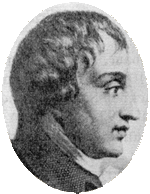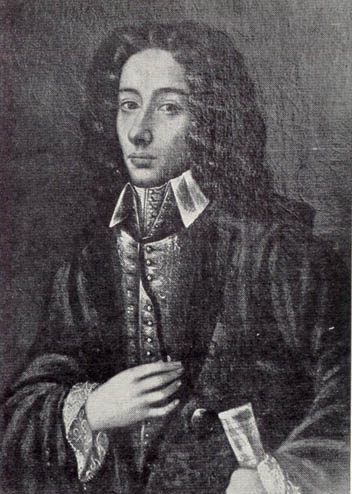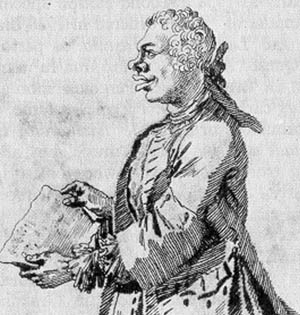

Italian composer. He probably studied with
the
maestro di cappella
at Iesi, Francesco Santi, and took violin with Francesco Mondini.
Sometime after 1720 he was sent to the Conservatorio dei Poveri
di Gesù Cristo in Naples, where he studied composition
with Gaetano Greco, Leonardo Vinci, and Francesco Durante; he
also performed as a choirboy and violinist. While still a
student, his
dramma sacro Li prodigi della divina
(1731) was performed at the monastery of S. Agnello Maggiore. His
first commissioned opera,
Salustia
(Naples, 1732), a revision of Zeno's
Alessandro Severo,
was probably written in haste and enjoyed little success.
 Pergolesi was appointed
maestro di cappella
to Prince Ferdinando Colonna Stigliano in 1732, and the same year
his
commedia musicale Lo firate 'nnamorato
was quite successful. After Naples experienced earthquakes in
November and December 1732, he composed some works to celebrate
the festival of St. Emidius (protector against earthquakes),
which apparently included a Mass for double chorus and the Psalms
Dixit Dominus, Laudate
(not extant), and
Confitebor.
In 1733 he was commissioned to write an opera for the empress's
birthday; the result,
Il prigionier superbo,
included the intermezzo
La serva padrona,
which would become one of his most celebrated works. In May 1734
his Mass in F was presented in the Church of S. Lorenzo in
Lucina, Rome, to an audience that included the Duke of Maddaloni;
subsequently Pergolesi entered his service as
maestro di cappella,
returned with the duke to Naples in 1734, and composed an opera
on Metastasio's
Adriano
in Siria in the same year. He was commissioned to set
Metastasio's
L'Olimpiade
for the Teatro Tordinona in Rome, where the work premiered in
1735; it appears to have been a failure, although a few years
later it was produced in Venice and Turin. His last success was
the
commedia musicale Il Flaminio
(Naples, 1735); a wedding serenata,
Il tempo felice
(1735, lost), was completed by Niccolò Sabbatino because
of Pergolesi's poor health.
Pergolesi was appointed
maestro di cappella
to Prince Ferdinando Colonna Stigliano in 1732, and the same year
his
commedia musicale Lo firate 'nnamorato
was quite successful. After Naples experienced earthquakes in
November and December 1732, he composed some works to celebrate
the festival of St. Emidius (protector against earthquakes),
which apparently included a Mass for double chorus and the Psalms
Dixit Dominus, Laudate
(not extant), and
Confitebor.
In 1733 he was commissioned to write an opera for the empress's
birthday; the result,
Il prigionier superbo,
included the intermezzo
La serva padrona,
which would become one of his most celebrated works. In May 1734
his Mass in F was presented in the Church of S. Lorenzo in
Lucina, Rome, to an audience that included the Duke of Maddaloni;
subsequently Pergolesi entered his service as
maestro di cappella,
returned with the duke to Naples in 1734, and composed an opera
on Metastasio's
Adriano
in Siria in the same year. He was commissioned to set
Metastasio's
L'Olimpiade
for the Teatro Tordinona in Rome, where the work premiered in
1735; it appears to have been a failure, although a few years
later it was produced in Venice and Turin. His last success was
the
commedia musicale Il Flaminio
(Naples, 1735); a wedding serenata,
Il tempo felice
(1735, lost), was completed by Niccolò Sabbatino because
of Pergolesi's poor health.  In 1736 he moved into a Franciscan
monastery in Puzzuoli, where during his final illness he composed
the cantata
Orfeo,
his
Stabat Mater,
and the
Salve Regina.
In 1736 he moved into a Franciscan
monastery in Puzzuoli, where during his final illness he composed
the cantata
Orfeo,
his
Stabat Mater,
and the
Salve Regina.
Pergolesi's fame spread rapidly after his death. Four of his cantatas were published posthumously, and traveling troupes of players began to perform his comedies, especially La serva padrona. In 1752 the tremendous success of this work in Paris, staged there for the second time, initiated the querelle des bouffons. The sacred music enjoyed considerable success as well, the Stabat Mater becoming a particular favorite of the 18th century. The enthusiasm for Pergolesi's works caused a considerable number of misattributions, which still cause confusion; Stravinsky's Pulcinella made use of material ascribed to Pergolesi, but in fact almost none of the works he selected are by the composer.